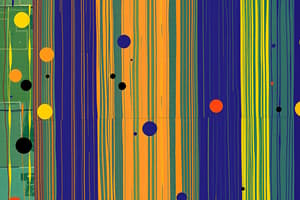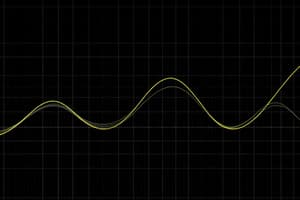Podcast
Questions and Answers
What does supervised machine learning heavily rely on?
What does supervised machine learning heavily rely on?
- Random data generation
- Historical data (correct)
- Real-time data feeds
- Unstructured data
Which of the following describes the relationship between independent variable x and dependent variable y in supervised learning?
Which of the following describes the relationship between independent variable x and dependent variable y in supervised learning?
- y is irrelevant to x
- y increases disproportionately with changes in x
- y increases with an increase in x (correct)
- y decreases as x decreases
What type of machine learning does NOT require historical data?
What type of machine learning does NOT require historical data?
- Predictive learning
- Supervised learning
- Reinforcement learning
- Unsupervised learning (correct)
Which of the following algorithms is mentioned as part of the unsupervised learning techniques?
Which of the following algorithms is mentioned as part of the unsupervised learning techniques?
How is traditional computer programming fundamentally different from machine learning in predicting outputs?
How is traditional computer programming fundamentally different from machine learning in predicting outputs?
What is the primary function of the Spark machine learning libraries?
What is the primary function of the Spark machine learning libraries?
In machine learning terms, what is the role of the y variable?
In machine learning terms, what is the role of the y variable?
What characteristic of Spark makes it suitable for big data processing?
What characteristic of Spark makes it suitable for big data processing?
What is the primary goal of supervised machine learning?
What is the primary goal of supervised machine learning?
What does the predictor function represent in the context of supervised learning?
What does the predictor function represent in the context of supervised learning?
How is prediction error defined in supervised learning?
How is prediction error defined in supervised learning?
In supervised learning, what represents the target variable that the hypothesis aims to model?
In supervised learning, what represents the target variable that the hypothesis aims to model?
Which method is used to separate data points into discrete sets in supervised learning?
Which method is used to separate data points into discrete sets in supervised learning?
What happens to prediction error when the hypothesis closely fits the training data?
What happens to prediction error when the hypothesis closely fits the training data?
What is the term used for the function that is used to predict the outcome of the dependent variable in supervised learning?
What is the term used for the function that is used to predict the outcome of the dependent variable in supervised learning?
In a linear regression scenario, how is the predicted value of y calculated for a given x?
In a linear regression scenario, how is the predicted value of y calculated for a given x?
What is the primary purpose of regression analysis?
What is the primary purpose of regression analysis?
In linear regression, what does the slope (b) of the regression line represent?
In linear regression, what does the slope (b) of the regression line represent?
What is the least squares method used for in regression analysis?
What is the least squares method used for in regression analysis?
What does a positive relationship between the independent variable (x) and dependent variable (y) indicate?
What does a positive relationship between the independent variable (x) and dependent variable (y) indicate?
Which type of regression involves multiple independent variables?
Which type of regression involves multiple independent variables?
What does the y-intercept (a) in the linear regression equation represent?
What does the y-intercept (a) in the linear regression equation represent?
What is a factor that might cause prediction error in regression analysis?
What is a factor that might cause prediction error in regression analysis?
Which method is commonly employed to visually represent the relationship in regression analysis?
Which method is commonly employed to visually represent the relationship in regression analysis?
What does a higher R-squared value indicate about a model?
What does a higher R-squared value indicate about a model?
What range does R-squared values fall within?
What range does R-squared values fall within?
What does a high standard error indicate about sample means?
What does a high standard error indicate about sample means?
In a generalized linear model, what does 'k' represent in the equation y = a0 + b1x1 + b2x2 + ... + bkxk?
In a generalized linear model, what does 'k' represent in the equation y = a0 + b1x1 + b2x2 + ... + bkxk?
Which statement is true regarding logistic regression?
Which statement is true regarding logistic regression?
What is the purpose of using standard error in regression analysis?
What is the purpose of using standard error in regression analysis?
Which of the following describes the logistic regression analysis purpose?
Which of the following describes the logistic regression analysis purpose?
What is the formula for calculating R-squared?
What is the formula for calculating R-squared?
What is a characteristic of classification in supervised learning?
What is a characteristic of classification in supervised learning?
What is the purpose of the training set in supervised learning?
What is the purpose of the training set in supervised learning?
Which of the following describes Spark's role in data processing?
Which of the following describes Spark's role in data processing?
What does the driver program in Spark do?
What does the driver program in Spark do?
In supervised learning, what typically represents the process of validation?
In supervised learning, what typically represents the process of validation?
What do Spark executor processes primarily do?
What do Spark executor processes primarily do?
What is the typical split rule used for training and validation sets?
What is the typical split rule used for training and validation sets?
What is one role of the cluster manager in Spark?
What is one role of the cluster manager in Spark?
Flashcards are hidden until you start studying
Study Notes
Supervised and Unsupervised Machine Learning
- Machine learning is categorized into two types: supervised and unsupervised learning.
- Supervised learning algorithms rely on historical data to make predictions on new data points.
- Unsupervised learning is used when there is no historical data available.
Supervised Learning (Linear Regression)
- Linear regression models the relationship between a dependent variable (y) and one or more independent variables (x).
- The relationship between x and y is represented by a straight line.
- The predictor function is a hypothesis that attempts to model the relationship between x and y.
- The goal of supervised learning is to minimize prediction error, the difference between the predicted value and the actual value.
Classification
- Classification separates data points into discrete sets known as classes, types, or categories.
- It defines a decision boundary that separates the output variables into different classes.
- Email classification is an example of a classification task.
- The generic supervised learning process involves splitting data into training and validation sets to train and evaluate the model.
The Spark Programming Model
- Spark is a distributed in-memory processing engine that handles large data volumes using Resilient Distributed Datasets (RDDs).
- Spark consists of three components:
- Driver: launches and manages Spark applications, schedules tasks, and distributes data.
- Executor: runs tasks, stores data in RDDs, and reports execution status.
- Cluster Manager: allocates resources to Spark applications.
Regression Analysis
- Regression analysis predicts or forecasts the occurrence of an event or the value of a continuous variable based on independent variables.
- It identifies which variables influence the outcome and their impact.
Linear Regression
- Simple linear regression models the relationship between a dependent variable (y) and one independent variable (x).
- Multiple linear regression involves multiple independent variables.
- The regression line represents the relationship between x and y and can be plotted on an x-y dimension.
Least Square Method
- The least square method minimizes prediction error by finding the regression line that best fits the training data.
R-squared
- R-squared measures the goodness of fit of a model.
- It represents the proportion of variability in the dependent variable that is explained by the independent variables.
- R-squared values range from 0% to 100%, with higher values indicating a better fit.
Standard Error
- Standard error measures the accuracy of the model by assessing how closely the sample data represents the population.
- A high standard error suggests a wide spread of data points and a less representative sample.
- A low standard error indicates a close distribution of data points and a more accurate representation.
Generalized Linear Model
- Generalized linear models handle situations with multiple dependent variables and correlation among predictor variables.
- This model can be used to predict a single dependent variable.
Logistic Regression - Classification Technique
- Logistic regression analyzes input variables to predict the binary classification of output variables.
- It is used for scenarios where the output variable has two possible outcomes, such as predicting whether an email is spam or not.
Studying That Suits You
Use AI to generate personalized quizzes and flashcards to suit your learning preferences.




